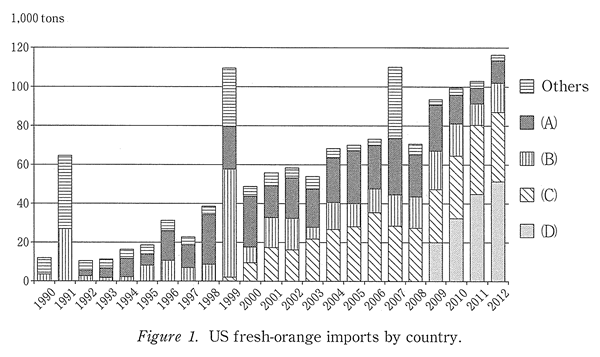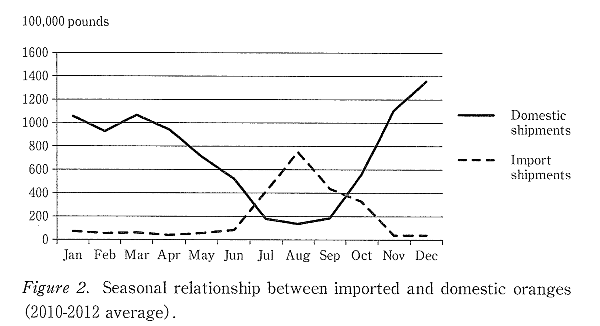問1
問題次の文章はある説明文の一部である。この文章を読み、下の問いの ( ) に入れるのに最も適当なものを、それぞれ下の1~4のうちから1つずつ選べ。
US consumer have benefited from an increased volume and variety of fresh-fruit imports, particularly since the 1990s. The fruit and vegetable section in today’s grocery store often has dozens of different fresh fruits on display all year around, which come from all corners of the globe as additions to domestic fresh fruit.
The rapid growth of fresh-fruit imports has affected many aspects of the US fresh-fruit market. For example, while oranges are the US’s leading domestically grown fruit, the volume of US orange imports has grown steadily since 1990s, with occasional sudden increases when the US crop experienced freezing weather (see Figure 1).

The US domestic market receives orange imports from various countries and regions. Among the major suppliers, Mexico is a longtime source. However, due to the strong US demand for fresh oranges throughout the year, the Southern Hemisphere countries have also become major suppliers, especially during the summer months when domestic navel oranges are not available. Australia was the first such country, starting in the early 1990s after it obtained permission from the US government to export its navel oranges there. Australia was followed by South Africa in the late 1990s, and most recently by Chile as well.
問1
In Figure 1, which of following do (A), (B), (C), and (D) refer to?
1. (A) Australia / (B) Chile / (C) Mexico / (D) South Africa
2. (A) Australia / (B) Mexico / (C) South Africa / (D) Chile
3. (A) South Africa / (B) Chile / (C) Australia / (D) Mexico
4. (A) South Africa / (B) Mexico / (C) Australia / (D) Chile
【解説】
図1で、(A)、(B)、(C)、および(D)はどれを参照していますか?
Figure 1 の(A)~(D)がどこの国を表わしているかを答える問題です。第三段落の内容を確認しながら、選択肢を絞っていきましょう。
まず Mexico について、こうあります。
「主要なサプライヤーの中で、メキシコは長年の供給源です」
longtime とありますので、(A)か(B)がメキシコのような感じがします。ただ、longtime というのは、人によってとらえ方が違います。(C)が1999年から登場していますので、それをもって「長年」と言われれはそうとも考えられます。
ただ、さすがに(D)を「長年」というのはおかしいので、まずこの段階で(D)がメキシコの線は消えます。選択肢 3. は消しておきましょう。
次に Australia について、こうあります。
「オーストラリアは、米国政府からネーブルオレンジの輸出許可を得て1990年代初頭に始めた、そのような最初の国でした」
1990年代初頭から始めているのですから、(A)か(B)が Australia でしょう。ただ、選択肢を確認すると(B)に Australia はありませんので、この時点で (A) の Australia は確定です。
(C)に Australia が入っている選択肢 4. は消しておきましょう。
その続きの文はこうなっています。
「1990年代後半には、南アフリカがオーストラリアに続き、最近ではチリが続きました」
この「続く」というのが何に対して続いているのかがポイントです。follow は順位にも使います。今回はグラフの問題ですので、その順位の話かと考えた人もいたかと思います。
実はそうではなくこの「続く」というのは、輸出許可を得てアメリカに輸出した順番のことなのです。
つまり1990年代後半に南アメリカがアメリカに輸出を始めて、最近チリがアメリカに輸出を始めたのです。ということで、(C)が南アメリカ、(D)がチリとなります。
【正解】2
問2
問題次の文章はある説明文の一部である。この文章を読み、下の問いの ( ) に入れるのに最も適当なものを、それぞれ下の1~4のうちから1つずつ選べ。
In the US, two main types of oranges are produced domestically: “navel oranges” and “Valencia oranges.” Navel oranges─virtually without seeds, with flesh that separates easily and is firm rather than watery─are the most popular oranges for eating fresh. The navel orange share of US production of fresh-market oranges was 76 percent during the years 2010-2012. In comparison, Valencia oranges─with thin skin, containing occasional seeds, and with juicy and sweet flesh─accounted for 24 percent during the same period. As the US’s top supplier of fresh-market oranges, California produced 87 percent of fresh-market navel oranges and more than 81 percent of fresh-market Valencia oranges.
The main harvest period for domestic fresh-market oranges is from November through May, a time when California’s navel oranges are in season. However, the amount of oranges produced and shipped domestically falls significantly from June through October. In earlier years, when fresh-orange imports still accounted for only a small portion of domestic use, Valencia oranges were popular variety when navel oranges were out of season. As seen in Figure 2, however, navel orange imports from the Southern Hemisphere countries have come to dominate the US in the summer season.

問2
According to the passage, which of the following correctly describes one difference between navel oranges and Valencia oranges?
1. Navel oranges contain fewer seeds than Valencia oranges do.
2. Navel oranges contain more juice than Valencia oranges do.
3. Valencia oranges are more popular than navel oranges in the winter.
4. Valencia oranges are more suitable for eating fresh than navel oranges.
【解説】
「その文章によると、ネーブルオレンジとバレンシアオレンジの違いを正しく説明しているのは次のうちどれですか」
1. Navel oranges contain fewer seeds than Valencia oranges do.
「ネーブルオレンジは、バレンシアオレンジよりも種子が少ない」
seeds に関しては、本文にこうあります。
「ネーブルオレンジは実際に種がなく…」
「バレンシアオレンジは、薄い皮を持ち、たまに種が含まれ…」
ということで、この選択肢が正解です。
2. Navel oranges contain more juice than Valencia oranges do.
「ネーブルオレンジには、バレンシアオレンジよりも果汁が多く含まれている」
Navel oranges については、こうあります。
「水っぽいというより固い」
Valencia oranges については、こうあります。
「ジューシーで甘い果肉があり」
ということで、バレンシアオレンジの方が果汁が含まれています。この選択肢は違います。
3. Valencia oranges are more popular than navel oranges in the winter.
「バレンシアオレンジは、ネーブルオレンジよりも冬に人気があります」
popular については、本文にこうあります。
「ネーブルオレンジが季節外れのとき、バレンシアオレンジは人気のある品種でした」
では、ネーブルオレンジが季節外れなのは、いつなのかということです。それはこの文の前に書かれてあります。
「国内の生鮮市場のオレンジの主な収穫期間は、カリフォルニアのネーブルオレンジが旬となる11月から5月までです」
そしてこう続きます。
「しかし、国内で生産、出荷されるオレンジの量は、6月から10月にかけて大幅に減少します」
ということで、バレンシアオレンジが人気があるのは6月~10月です。これは「冬」ではありません。ということで、この選択肢は違います。
4. Valencia oranges are more suitable for eating fresh than navel oranges.
「バレンシアオレンジはネーブルオレンジよりも新鮮な食事に適しています」
ネーブルオレンジについて、こうあります。
「新鮮な食事に最も人気のあるオレンジです」
ネーブルオレンジがもっとも人気があるのですから、この選択肢は違います。
【正解】1
問3
問題次の文章はある説明文の一部である。この文章を読み、下の問いの ( ) に入れるのに最も適当なものを、それぞれ下の1~4のうちから1つずつ選べ。
US consumer have benefited from an increased volume and variety of fresh-fruit imports, particularly since the 1990s. The fruit and vegetable section in today’s grocery store often has dozens of different fresh fruits on display all year around, which come from all corners of the globe as additions to domestic fresh fruit.
The rapid growth of fresh-fruit imports has affected many aspects of the US fresh-fruit market. For example, while oranges are the US’s leading domestically grown fruit, the volume of US orange imports has grown steadily since 1990s, with occasional sudden increases when the US crop experienced freezing weather (see Figure 1).
The US domestic market receives orange imports from various countries and regions. Among the major suppliers, Mexico is a longtime source. However, due to the strong US demand for fresh oranges throughout the year, the Southern Hemisphere countries have also become major suppliers, especially during the summer months when domestic navel oranges are not available. Australia was the first such country, starting in the early 1990s after it obtained permission from the US government to export its navel oranges there. Australia was followed by South Africa in the late 1990s, and most recently by Chile as well.
In the US, two main types of oranges are produced domestically: “navel oranges” and “Valencia oranges.” Navel oranges─virtually without seeds, with flesh that separates easily and is firm rather than watery─are the most popular oranges for eating fresh. The navel orange share of US production of fresh-market oranges was 76 percent during the years 2010-2012. In comparison, Valencia oranges─with thin skin, containing occasional seeds, and with juicy and sweet flesh─accounted for 24 percent during the same period. As the US’s top supplier of fresh-market oranges, California produced 87 percent of fresh-market navel oranges and more than 81 percent of fresh-market Valencia oranges.
The main harvest period for domestic fresh-market oranges is from November through May, a time when California’s navel oranges are in season. However, the amount of oranges produced and shipped domestically falls significantly from June through October. In earlier years, when fresh-orange imports still accounted for only a small portion of domestic use, Valencia oranges were popular variety when navel oranges were out of season. As seen in Figure 2, however, navel orange imports from the Southern Hemisphere countries have come to dominate the US in the summer season.
問3
What is the main purpose of this passage?
1. To account for the seasonal changes in the US production of oranges
2. To explain the differences between navel oranges and Valencia oranges
3. To illustrate the relation between US production and import of oranges
4. To improve the quality of the navel oranges produced in the US
【解説】
「この文章の主要な目的は何ですか」
1. To account for the seasonal changes in the US production of oranges
「米国のオレンジ生産の季節変動を明らかにする」
第五段落の最初はこうなっています。
「国内の生鮮市場のオレンジの主な収穫期間は、カリフォルニアのネーブルオレンジが旬となる11月から5月までです」
第五段落にこの選択肢の内容がありますが、それ以外の段落では述べられていません。この選択肢は違います。
2. To explain the differences between navel oranges and Valencia oranges
「ネーブルオレンジとバレンシアオレンジの違いを説明する」
第四段落の最初はこうなっています。
「米国では、主に2つのタイプのオレンジが国内で生産されています。「ネーブルオレンジ」と「バレンシアオレンジ」です」
第四段落と第五段落にこの選択肢の内容がありますが、それ以外の段落では述べられていません。この選択肢は違います。
3. To illustrate the relation between US production and import of oranges
「米国の生産とオレンジの輸入の関係を説明する」
説明文のテーマは最初にあることが多いです。本文最初の文はこうなっています。
「米国の国内市場は、さまざまな国や地域からオレンジ色の輸入品を受け取っています」
ということで、この選択肢が正解です。
4. To improve the quality of the navel oranges produced in the US
「米国で生産されるネーブルオレンジの品質を向上させる」
「品質の向上」なんて話はありませんでしたね。この選択肢は違います。
【正解】3
問4
問題次の文章はある報告書の一部である。この文章とグラフを読み、下の問いの( )に入れるのに最も適当なものを、それぞれ下の1~4のうちから1つずつ選べ。
Because of seasonal production patterns, the majority of Mexico’s oranges arrive in the US market from December through June, when US supplies are relatively high. In contrast, the season for imports from the Southern Hemisphere countries is mainly from July through October, when US supplies are relatively low. This trend is similar to that seen with many other fruits as well.
(Sophia Wu Huang (2013) Imports Contribute to Year-Round Fresh Fruit Availability を参考に作成)
問4
What topic is most likely to follow the latest paragraph?
1. Export rates of other fruits from the US to the Southern Hemisphere
2. Statistics showing the seasonal changes in imports of other fruits
3. The shipping methods of navel oranges from the Southern Hemisphere
4. The variety of fruits commonly grown in the US and Mexico
【解説】
「最後の段落に続く可能性が最も高い話題は何ですか」
最後の文はこうなっています。
「この傾向は、他の多くの果物でも見られる傾向と似ています」
「この傾向」とは何を指しているのでしょう。
「季節的な生産パターンのため、メキシコのオレンジの大部分は、米国の供給量が比較的多い12月から6月に米国市場に到着します」
「対照的に、南半球諸国からの輸入の季節は主に米国の供給が比較的少ない7月から10月までです」
この二つの話が、「この傾向」が指している内容です。オレンジの輸入先が、季節によって変わるという話です。
そしてそれがオレンジだけではなく、他の果物も同じ傾向にあると最後の文で言っているのです。ということは、その「他の果物」の「季節による輸入の変化」という話が次に述べられそうですね。
それを踏まえて選択肢を確認してみましょう。
1. Export rates of other fruits from the US to the Southern Hemisphere
「その他の果物の米国から南半球への輸出率」
この選択肢は、一瞬迷うところですね。ですが、落ち着いて見てみると選択肢は、アメリカからの「Export / 輸出」です。本文では「import / 輸入」です。
ということで、この選択肢は違います。
2. Statistics showing the seasonal changes in imports of other fruits
「他の果物の輸入の季節変化を示す統計」
先ほど確認した内容と合っているのは、この選択肢ですね。この選択肢が正解です。
3. The shipping methods of navel oranges from the Southern Hemisphere
「南半球からのネーブルオレンジの発送方法」
第五段落の最後にこうあります。
「ただし、図2が示すように、南半球諸国からのネーブルオレンジの輸入が、夏季に米国を支配するようになりました」
選択肢にある「shipping methods / 発送方法」というのが、図2にある通り、アメリカの収穫が少ない時期に発送していることを指しているのであれば、もう書かれてあります。
もう少し具体的な方法、例えば缶詰にしてから発送するとか、熟れる少し前に収穫しておき、発送中に熟させるとか、そういう話であるなら、本文には書かれてありません。
ですが、最初に確認した通り「他の果物」の話が続きそうなので、ネーブルオレンジの話であるこの選択肢は違います。
4. The variety of fruits commonly grown in the US and Mexico
「アメリカとメキシコで一般的に栽培されている果物の種類」
最初に確認した通り「輸入の季節変化」の話が続きそうなので、この選択肢は違います。
【正解】2



コメントをどうぞ